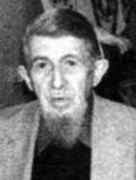Person: Du Val, Patrick

Patrick Du Val was an English mathematician who worked in algebraic geometry, differential geometry and general relativity.
Mathematical Profile (Excerpt):
- They got to know Henry Baker and he persuaded Patrick to undertake research into algebraic geometry at Cambridge; Du Val matriculated as a research student at Cambridge in 1927.
- Baker's research group contained a remarkable collection of geometers: Donald Coxeter, Leonard Edge, William Hodge and John Semple were all close to Du Val in age (only one year separated them all), and there also was the younger John Todd.
- During his period as a research student these geometers, all later making outstanding mathematical contributions, became good friends and Du Val formed a particularly strong friendship with Coxeter and Semple.
- With Baker as his thesis advisor, Du Val wrote the thesis On certain configurations of algebraic geometry, having groups of self-transformations representable by the symmetry groups of certain polytopes for which he received a Ph.D. in 1930.
- Interesting as were Mr Richmond's investigations as to the possibility of expressing a given number as the sum of three cubes, many of his hearers must have regretted the loss of his very valuable researches on the Canonical Curve of genus 5, which he apparently decided at the last moment were not at a sufficiently advanced stage to form conveniently the subject for his paper.
- In the same year of 1930, Du Val achieved the unusual feat of being awarded a Fellowship of Trinity College after only three years of research.
- In addition to the work of his Ph.D., which he did not publish until 1933, Du Val published two papers during his three undergraduate years: On questions of reality for twisted quartics of the first kind (1928) and On the Hesse-Cayley algorithm for a plane quartic whose bitangents are all real (1929).
- Du Val held the Trinity Fellowship for four years during which time he visited Rome working with Federigo Enriques.
- This was an exciting time for Du Val who became deeply interested in the theory of algebraic surfaces.
- In July 1935 Du Val and Coxeter gave a joint presentation to the Pittsburgh meeting of the American Association for the Advancement of Science.
- He was unlucky in that Hodge submitted a truly remarkable essay on harmonic integrals for the 1936 Adams Prize which won, beating not only Du Val but also Coxeter and others.
- During this time (in 1938) he published a pamphlet of 26 pages written jointly with H S M Coxeter, H T Flather, and J F Petrie entitled The Fifty-nine Icosahedra.
- The idea for the pamphlet was due to Coxeter who wanted to construct models of 59 polyhedral stellations and write a paper to explain them but, realising the immense amount of work involved, enlisted the help of three friends, one of whom was Du Val.
- The pamphlet was reprinted in 1951, then 44 years after it was first published, Du Val brought out a second edition in 1982.
- After five years in Manchester, Du Val went to Istanbul in 1941 to take up the chair of Pure Mathematics.
- He publication record during this period was no longer the remarkable one of the years 1932-36 when he had published 19 papers.
- Together with Semple he led the London Geometry Seminar during the time he spent in London.
- After he retired Du Val returned to Istanbul and for three years where he held the same post as he had held 30 years before.
- As we noted above, Du Val's early work before he became a research student at Cambridge was on relativity.
- He worked on algebraic surfaces, especially during his time in Rome, and he published the important monograph Homographies, quaternions and rotations in 1964.
- Later in his career Du Val became interested in elliptic functions publishing the book Elliptic functions and elliptic curves in 1973.
- We note that Du Val was an invited speaker at the British Mathematical Colloquium held in Nottingham in 1957 when he gave the lecture Quaternions and polytopes in four dimensions.
- Du Val was always interested in teaching as well as research.
- At other people's lectures, he was noted for the quickness with which he grasped new ideas; and his courteous interventions were often the makings of what would otherwise have been rather dull seminars.
- Du Val was a remarkable man to know and a most amusing companion.
Born 26 March 1903, Cheadle Hulme (near Manchester), Cheshire, England. Died 22 January 1987, Cambridge, England.
View full biography at MacTutor
Tags relevant for this person:
Origin England
Thank you to the contributors under CC BY-SA 4.0! 

- Github:
-

- non-Github:
- @J-J-O'Connor
- @E-F-Robertson
References
Adapted from other CC BY-SA 4.0 Sources:
- O’Connor, John J; Robertson, Edmund F: MacTutor History of Mathematics Archive
